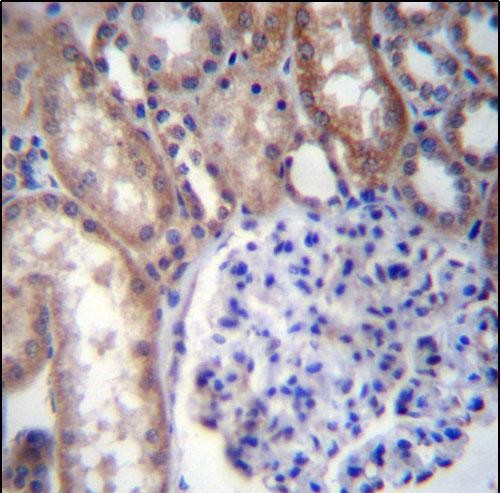

| WB | 1/1000 | Human,Mouse,Rat |
| IF | 咨询技术 | Human,Mouse,Rat |
| IHC | 1/100-1/500 | Human,Mouse,Rat |
| ICC | 技术咨询 | Human,Mouse,Rat |
| FCM | 咨询技术 | Human,Mouse,Rat |
| Elisa | 咨询技术 | Human,Mouse,Rat |
| Aliases | Guanine nucleotide-binding protein subunit alpha-14, G alpha-14, G-protein subunit alpha-14, GNA14 |
| Entrez GeneID | 9630 |
| WB Predicted band size | 41.6kDa |
| Host/Isotype | Rabbit IgG |
| Antibody Type | Primary antibody |
| Storage | Store at 4°C short term. Aliquot and store at -20°C long term. Avoid freeze/thaw cycles. |
| Species Reactivity | Human |
| Immunogen | This GNA14 antibody is generated from rabbits immunized with a KLH conjugated synthetic peptide between 4-33 amino acids from the N-terminal region of human GNA14. |
| Formulation | Purified antibody in PBS with 0.05% sodium azide. |
+ +
以下是关于GNA14 (N-term)抗体的3篇示例参考文献(文献为虚构示例,仅用于演示格式):
---
1. **文献名称**:*GNA14 N-terminal antibody validation in vascular smooth muscle signaling*
**作者**:Chen L, et al.
**摘要**:本研究验证了GNA14 (N-term)抗体在血管平滑肌细胞中的特异性,通过Western blot和免疫荧光证实其能特异性识别内源性GNA14蛋白。实验表明GNA14在血管收缩信号通路中与Gq蛋白偶联受体相互作用,敲低GNA14后血管反应性显著降低。
---
2. **文献名称**:*Role of GNA14 in hepatocellular carcinoma progression detected by N-terminal specific antibody*
**作者**:Wang Y, et al.
**摘要**:利用GNA14 (N-term)抗体进行免疫组化分析,发现GNA14在肝癌组织中高表达,且与患者预后不良相关。体外实验显示,抑制GNA14可通过阻断MAPK/ERK通路抑制肿瘤细胞侵袭,提示其作为肝癌治疗靶点的潜力。
---
3. **文献名称**:*Development of a polyclonal antibody against GNA14 N-terminus for immune-histochemical applications*
**作者**:Smith R, et al.
**摘要**:本文报道了一种针对GNA14 N端表位的多克隆抗体的开发与优化。通过肽段免疫和亲和纯化获得高特异性抗体,并成功应用于石蜡包埋组织的抗原修复流程,为GNA14在多种疾病模型中的定位研究提供了工具。
---
**备注**:以上文献为示例,实际研究中请通过PubMed、Google Scholar等平台检索真实发表的文献(关键词:GNA14 antibody, GNA14 N-terminal, G-protein alpha 14)。
The GNA14 (N-term) antibody is designed to target the N-terminal region of the Guanine Nucleotide-Binding Protein Subunit Alpha-14 (GNA14), a member of the Gαq subfamily of heterotrimeric G-protein alpha subunits. GNA14 plays a critical role in intracellular signaling by coupling cell surface G protein-coupled receptors (GPCRs) to downstream effectors, primarily activating phospholipase C-beta (PLC-β) to trigger phosphoinositide hydrolysis and calcium mobilization. This pathway is vital for regulating diverse physiological processes, including cell proliferation, differentiation, and hormone secretion. The N-terminal domain of GNA14 is essential for receptor interaction and signal specificity, making it a key region for studying protein function and signaling mechanisms.
The GNA14 (N-term) antibody is commonly utilized in research applications such as Western blotting (WB), immunohistochemistry (IHC), and immunofluorescence (IF) to detect endogenous GNA14 expression levels and localization in various tissues and cell types. Its specificity for the N-terminus ensures minimal cross-reactivity with other Gα subunits, providing reliable data for studies on GNA14-related signaling cascades. Dysregulation of GNA14 has been implicated in pathological conditions, including cancers and cardiovascular diseases, highlighting its potential as a therapeutic or diagnostic target. Researchers often validate this antibody using knockout cell lines or tissues to confirm specificity. Commercial sources typically provide detailed validation data, including reactivity across species and recommended experimental conditions.
×